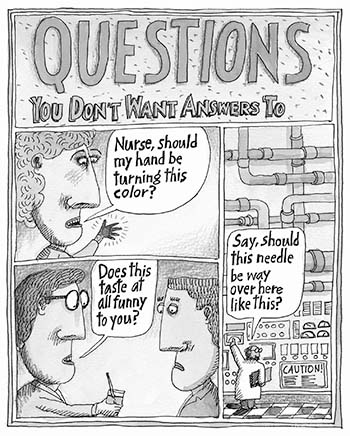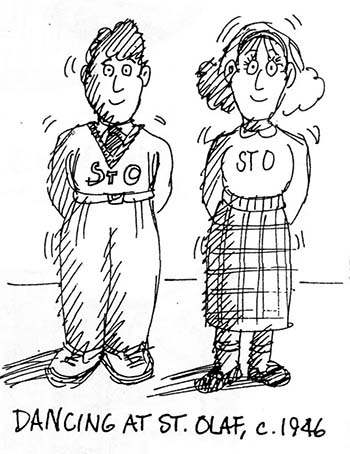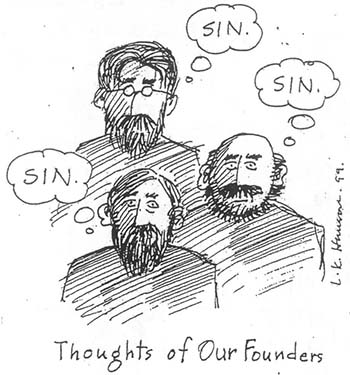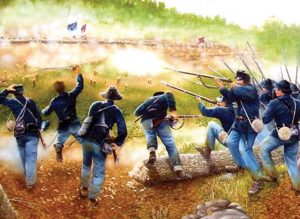
L.K. (Larry) Hanson, creator of a popular St. Olaf comic strip in the ’60s and long-time StarTribune illustrator and writer, came to Northfield recently to talk with me about his life and career for this October issue focusing on visual arts. We are pleased to be able to feature examples of the work of this talented artist with my column.
A resident of northeast Minneapolis today, Hanson grew up on a farm near Lake Mills, Iowa, and describes himself as a “city mouse trapped in the body of a country mouse.” He showed a talent for art at an early age and was always drawing, basically self-taught, as there were no art classes available. Hanson knew he wanted a liberal arts education and followed the recommendation of an English teacher and Ole grad at his school, Roland Froyen, to apply to St. Olaf.
Hanson was the first in his family to go to college and both he and his parents were “kind of intimidated” as he was dropped off at Kildahl Hall in the fall of 1962. Although there were other students from small towns, they came from families of professionals, such as ministers, lawyers and teachers. His first drawing class was “dispiriting,” as he found himself outside on a cold October day, wearing gloves for warmth with fingers cut off, trying to draw a picture of Steensland Hall in perspective.
Hanson remembers thinking, “Is a career in art what I want? Because I think I am failing and I am only 19 years old!” But Hanson persisted and was encouraged by his advisor, John Maakestad, who told him, “You have the talent!” and if he kept at it, he would be okay. Maakestad (still working as an artist in Nerstrand) recalls that Hanson always “did his assignments in his own way, with a special twist.” Hanson, says Maakestad, always seemed to “know what he wanted to do” and was always “imaginative and inventive,” whether it was in art or participating in plays with a campus group called “The Playmakers.”
It was Hanson’s friend Jim Munson who saw some of Hanson’s cartoons and told him to show them to the Manitou Messenger editor, Tim Fossum. Hanson found he enjoyed hanging out with the “kind of crazy and smart and funny” English majors in the “Mess” office in the basement of Steensland. And the comic strip, “Uglies,” which debuted in Hanson’s sophomore year, was (as Hanson says) “a hit from the get-go.” Through his comic characters, Hanson commented on campus life in what he describes as his “Midwestern, Norwegian, kind of iconoclast, kind of provocateur” way of being able to make a point, yet in a humorous manner. (See accompanying story.)
After Hanson graduated from St. Olaf in 1966, he spent two years in the Peace Corps teaching English as a foreign language in the Philippines and then “shot to the top of the list” for Army service after these deferments. Hanson says he does not regret his Peace Corps experience, though altruistic expectations of building schools and “teaching the American way of life” clashed with the realities of poverty, ignorance and lack of facilities. But knowing that he was going into the Army was “one of the worst periods of my life,” says Hanson. During basic training in Fort Campbell, Kentucky, Hanson remembers thinking, “I’m 25 years old and I’m going to die in the next two years.” He felt hopeless: “And I wasn’t alone. That’s how it was and people like me did die, that was the reality of it.”
Hanson was sent to Germany and was a sergeant in the military police, working in the security section. He was able to do some art for a battalion publication, as he had also done in the Peace Corps (“I always had a toe dipped in that pool”). After his army service ended in 1970, an art professor at St. Olaf, Arch Leean, helped him find work at an animation studio in the Twin Cities. However, this “dream job” for someone who had grown up a Disney fan turned out to be “a lot of drudgery,” sequential drawings which “you couldn’t hang on the wall” and which lasted 15 seconds on film.
Ad agency and bookstore work followed. Hanson found himself at the right place at the right time when a reporter friend named Steve Berg helped him make a connection at the Minneapolis Tribune. He ended up replacing someone with a health issue.
Hanson looked around the news room and thought, “This is really, really fabulous.” He liked the people he was working with and relished the opportunity to find out “Am I good enough to do what I would like to do?” He was, indeed. What he learned was “the way to do something was to carve out your own place… I was doing things nobody else had done.”
The paper’s weekend arts and entertainment section was called “The Friday Special” at that time. Berg and Hanson teamed up and were given “carte blanche” by the editor, Bev Kees. There were times when the front page of the section would be filled with cartoons, drawings and writing that came out of their collaborations. The early 1980s, says Hanson, were the profitable, “halcyon days of the paper.”

Hanson loved the challenge of being able to come up with illustrations for a dull story. If someone gave him a business story and said, “OK, there’s nothing you can possibly say or make funny about this!” Hanson would reply, “Oh, I bet there is! Let me at it!”
Hanson has also been given writing assignments at the StarTribune, including book reviews and essays, and hopes to do more writing in the future. He took early retirement three years ago after almost 30 years at the newspaper, but still illustrates and writes a weekly feature on Mondays’ “Opinion Exchange” page called “You Don’t Say.” Hanson says his usual routine is to read the StarTribune and the New York Times in the morning to stimulate his thinking. Hanson generally picks about six weeks’ worth of quotations ahead of time, then works on one each week. The creative process involved in illustrating a quote takes a while and he will often “walk around” thinking. He gives himself leeway to make a substitution “if there’s something in the news that grabs me.”

Hanson has kept up a relationship with his alma mater and Northfield over the years. In 1983, he spent a semester as an artist-in-residence on campus and remembers being shocked at that time that students were going to business classes in suits and ties. In the spring of 1995 Hanson had a month-long show of his art at the Northfield Arts Guild. His parents, sister and brothers came from Lake Mills and Hanson recalls his father proudly telling people, “My kid did this!” Hanson had a gallery talk and exhibition at the Dittmann Art Center at St. Olaf in September 2003 called “If It’s In by Noon, It’s Art by 5” and a very popular “Journeys” presentation for alumni in February of 2008.

When I asked Hanson what he had taken most from his time at St. Olaf, he replied, “There was always that kind of undercurrent of service that was important, doing things for the community, doing things for others and also being a steward of your own life and doing what you feel you should be doing. And that’s something that I have really carried with me for a long time.”

Hanson reflected on how his art can “make people think about what’s going on.” When he first started working at the paper, he thought about how “more people saw my work in one day than had seen it in my entire life.” He appreciates this recognition, but he says that one of the nicest things anyone can say to him is that they have one of his illustrations on their refrigerator or at their cubicle at work. It shows “I’ve done my job” because he has given something of significance to them.

Enjoy the examples of Hanson’s art shown in this October Guide. And, if you feel so inclined, put them on your refrigerator!
Thanks to L.K. Hanson for his cooperation with this story and for sharing his abundant talent with us and to Jeff Sauve of the St. Olaf College Archives for research assistance.
What the Ding-Dong? A Look Back at L.K. Hanson’s “Uglies”

Gadzooks! Great gobs! What the ding-dong? Bert and Gwenellda, Euphasia, Elodea and Professor Drudge. These were among the expressions and names familiar to students at St. Olaf during the years 1963-1966 who grabbed up copies of the Manitou Messenger school paper to find out about the latest drama and trauma the cartoon characters of L.K. Hanson were going through each week. The unusual names and expressions came from his being a fan of television cartoons such as “The Rocky and Bullwinkle Show,” which were wacky and surreal and made people laugh.
As described in typically understated fashion on the title page of a booklet of 50 cartoons called “Three Ugly Years,” Hanson’s cartoon strips offer “trenchant social commentary!! The follies & foibles of student life! A penetrating look into the St. Olaf establishment!! Presented in wiggly lines & squiggly letters by L.K. Hanson…A memorable cartoon extravaganza to have and to hold for years & years to come!” (“Woo! Woo!” says Bert, clad in – well, nothing but beanie and propeller. “Uglies” might wear headgear on their dominant feature, but not much else. Not too surprising, as their chins reach their feet.)
Even though more than 40 years have passed since the Uglies trod Manitou Heights, there are familiar themes. Parents visit campus and don’t recognize their (now hirsute) son. They bring supplies from home including “a box of fudge from your Aunt Minnie” and “your moose trophy.” Gwenellda’s parents vow to find that “nasty professor who gave you that ‘D’ in German and we’ll straighten everything out.” A student freaks out when a traditional place to study in the library is occupied by someone else. The annual Christmas festival inspires a parody, “What place is this so packed and cramped, where restless crowds are perspiring?”
A snow storm obliterates sight as a student cries out, “Stop! Everybody! I just dropped a contact!” while another rhapsodizes, “I love it! Isn’t it great! Great gobs! I wish we had weather like this out in California.” Elodea boasts about not going to chapel and, in “divine retribution,” snow falls off the roof of Boe Memorial Chapel and buries her. Gwenellda is forced to spend the night in a doghouse next to the Ole Store during a spring blizzard.
Hanson says, “The best thing was dealing with the quotidian existence of daily campus life and seeing sort of crazy absurdities and behaviors…I love Nabokov, the novelist. It’s always detail, pay attention to details because that’s what people relate to. That’s where the universal truths are.” For Hanson, Bert and Gwenellda were “kind of observers and participants at the same time” and were his voice through which he was able to show the universal truths and “follies and foibles” of student life to all those on the St. Olaf campus from 1963 to 1966. And, gadzooks, was it ever entertaining!






